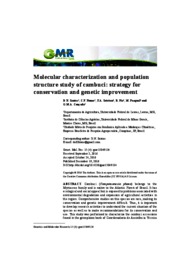Molecular characterization and population structure study of cambuci: strategy for conservation and genetic improvement.
Molecular characterization and population structure study of cambuci: strategy for conservation and genetic improvement.
Author(s): SANTOS, D. N.; NUNES, C. F.; SETOTAW, T. A.; PIO, R.; PASQUAL, M.; CANÇADO, G. M. de A.
Summary: Cambuci (Campomanesia phaea) belongs to the Myrtaceae family and is native to the Atlantic Forest of Brazil. It has ecological and social appeal but is exposed to problems associated with environmental degradation and expansion of agricultural activities in the region. Comprehensive studies on this species are rare, making its conservation and genetic improvement difficult. Thus, it is important to develop research activities to understand the current situation of the species as well as to make recommendations for its conservation and use. This study was performed to characterize the cambuci accessions found in the germplasm bank of Coordenadoria de Assistência Técnica Integral using inter-simple sequence repeat markers, with the goal of understanding the plant´s population structure. The results showed the existence of some level of genetic diversity among the cambuci accessions that could be exploited for the genetic improvement of the species. Principal coordinate analysis and discriminant analysis clustered the 80 accessions into three groups, whereas Bayesian modelbased clustering analysis clustered them into two groups. The formation of two cluster groups and the high membership coefficients within the groups pointed out the importance of further collection to cover more areas and more genetic variability within the species. The study also showed the lack of conservation activities; therefore, more attention from the appropriate organizations is needed to plan and implement natural and ex situ conservation activities.
Publication year: 2016
Types of publication: Journal article
Observation
Some of Embrapa's publications are published as ePub files. To read them, use or download one of the following free software options to your computer or mobile device. Android: Google Play Books; IOS: iBooks; Windows and Linux: Calibre.
Access other publications
Access the Agricultural Research Database (BDPA) to consult Embrapa's full library collection and records.
Visit Embrapa Bookstore to purchase books and other publications sold by Embrapa.

